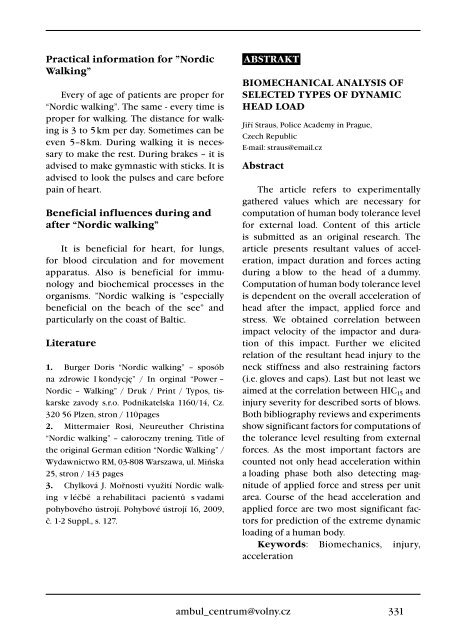3+4+Supplementum/2012 - Společnost pro pojivové tkáně
3+4+Supplementum/2012 - Společnost pro pojivové tkáně
3+4+Supplementum/2012 - Společnost pro pojivové tkáně
- TAGS
- www.pojivo.cz
Create successful ePaper yourself
Turn your PDF publications into a flip-book with our unique Google optimized e-Paper software.
Practical information for ”nordic<br />
walking”<br />
Every of age of patients are <strong>pro</strong>per for<br />
“Nordic walking”. The same - every time is<br />
<strong>pro</strong>per for walking. The distance for walking<br />
is 3 to 5 km per day. Sometimes can be<br />
even 5–8 km. During walking it is necessary<br />
to make the rest. During brakes – it is<br />
advised to make gymnastic with sticks. It is<br />
advised to look the pulses and care before<br />
pain of heart.<br />
Beneficial influences during and<br />
after “nordic walking”<br />
It is beneficial for heart, for lungs,<br />
for blood circulation and for movement<br />
apparatus. Also is beneficial for immunology<br />
and biochemical <strong>pro</strong>cesses in the<br />
organisms. ”Nordic walking is ”especially<br />
beneficial on the beach of the see” and<br />
particularly on the coast of Baltic.<br />
literature<br />
1. Burger Doris “Nordic walking” – sposób<br />
na zdrowie I kondycję” / In orginal “Power –<br />
Nordic – Walking” / Druk / Print / Typos, tiskarske<br />
zavody s.r.o. Podnikatelska 1160/14, Cz.<br />
320 56 Plzen, stron / 110pages<br />
2. Mittermaier Rosi, Neureuther Christina<br />
“Nordic walking” – całoroczny trening. Title of<br />
the original German edition “Nordic Walking” /<br />
Wydawnictwo RM, 03-808 Warszawa, ul. Mińska<br />
25, stron / 143 pages<br />
3. Chylková J. Mořnosti využití Nordic walking<br />
v léčbě a rehabilitaci pacientů s vadami<br />
pohybového ústrojí. Pohybové ústrojí 16, 2009,<br />
č. 1-2 Suppl., s. 127.<br />
aBSTRakT<br />
ambul_centrum@volny.cz<br />
BiOMeCHaniCal analYSiS Of<br />
SeleCTed TYPeS Of dYnaMiC<br />
Head lOad<br />
Jiří Straus, Police Academy in Prague,<br />
Czech Republic<br />
E-mail: straus@email.cz<br />
abstract<br />
The article refers to experimentally<br />
gathered values which are necessary for<br />
computation of human body tolerance level<br />
for external load. Content of this article<br />
is submitted as an original research. The<br />
article presents resultant values of acceleration,<br />
impact duration and forces acting<br />
during a blow to the head of a dummy.<br />
Computation of human body tolerance level<br />
is dependent on the overall acceleration of<br />
head after the impact, applied force and<br />
stress. We obtained correlation between<br />
impact velocity of the impactor and duration<br />
of this impact. Further we elicited<br />
relation of the resultant head injury to the<br />
neck stiffness and also restraining factors<br />
(i.e. gloves and caps). Last but not least we<br />
aimed at the correlation between HIC 15 and<br />
injury severity for described sorts of blows.<br />
Both bibliography reviews and experiments<br />
show significant factors for computations of<br />
the tolerance level resulting from external<br />
forces. As the most important factors are<br />
counted not only head acceleration within<br />
a loading phase both also detecting magnitude<br />
of applied force and stress per unit<br />
area. Course of the head acceleration and<br />
applied force are two most significant factors<br />
for prediction of the extreme dynamic<br />
loading of a human body.<br />
keywords: Biomechanics, injury,<br />
acceleration<br />
331

















